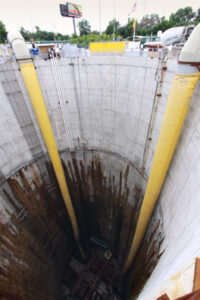
About 8 miles southwest of Chicago near Interstate 55, the Metropolitan Water Reclamation District of Greater Chicago is working on the latest phase of a massive project to expand its deep tunnel system. The ultimate goal: keeping up to 17 billion gallons of waste and storm water from flowing into Lake Michigan and nearby rivers when heavy storms hit.
The agency is building a series of reservoirs to hold storm runoff, the largest of which lies in south suburban McCook. This summer, crews from Kiewit Infrastructure continue their work to connect the reservoir with the 109-mile tunnel network, focusing on construction of the main gate and shaft that will regulate flow between the network and the McCook reservoir.
The gate assembly consists of 6 concrete shafts that hold 3 sets of metal-wheel gates, creating a system of 6 wet wells that serve as a holding tank between tunnel and reservoir, says Joe Ungari, Prairie Senior Account Manager working with Kiewit.
This structure, 88 feet in diameter and extending 280 feet below grade, will be built over a 2-year schedule with a concrete liner placed in 3-foot wide, 8-foot by 10-foot lifts. A challenge in itself – but as plans moved forward, mix temperature became the main issue, Ungari explains.
Specs demand a new approach
“Preventing thermal cracking is critical with these mass pours,” says Prairie Technical Services Director Steve Fleming. “Current mass concrete specs dictate that the maximum heat of hydration cannot exceed 160 degrees but in this case, the Army Corps of Engineers went a step further, specifying a slag-rich mix to be delivered at less than 70 degrees.”
“This requirement couldn’t be met by chilling the mix with with cooled water or ice,” Fleming says. “We knew liquid nitrogen would be the only approach.”
Fleming and his team called on experts at Canada Building Materials to learn more about LN cooling. Prairie and CBM are member companies of Votorantim Cement North America, or VCNA.
“We’ve been using LN technology for more than 25 years now,” says Phil Zacarias , CBM’s Quality Control Director. “It’s the best solution for mass pours like this one where low heat of hydration is crucial.”
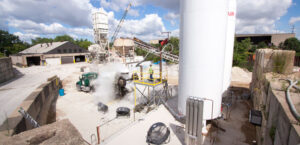
Bringing LN to Yard 33
Five Prairie staffers from QC, operations and maintenance toured CBM batch plants, where workers use 7 permanent LN stations to chill concrete inside truck barrels. A motorized and electrically actuated lance is used to inject LN directly into the hopper as the barrel rotates at a specified speed. Cooling takes just 2 to 10 minutes, depending on target temperature.
Prairie staff used CBM’s platform design to direct the installation of 2 cooling stations at Yard 33, about 5 miles from the Kiewit job site. Yard workers underwent special training following CBM’s dispensing and safety protocols.
In June the stations went into operation. “Now we’re supporting 3 weekly pours of about 350 yards each, or 40 continuously dispatched loads of cooled concrete,” says Mike Urlacher , Yard 33’s quality control expert.
Cooling without changing the mix
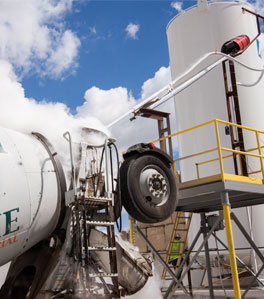
Gearing up for this level of production involved careful testing. “We’ve found that a 5-minute blast of LN cools the mix from 88 to 63 degrees,” Urlacher says. Tests performed after cooling confirm zero change in slump or air entrainment. That’s the big benefit with LN, says Fleming: “It’s inert, so it cools the concrete but leaves all other mix characteristics unchanged.”
Cooling depends on the length of time the concrete is exposed to LN rather than the dosage used. Exposure time is determined by load size, starting concrete temperature, the target temperature and head pressure in the LN tank, since cooling slows as the tank empties and pressure drops. For this job, target mix temperature at the yard was set at 63 degrees to meet the placement spec of 70 degrees or cooler.
“On hot days it can take up to 9 minutes to cool each load,” says Urlacher. Tests are run every 5 to 10 loads with more frequent monitoring in variable weather.
Safe for workers and the environment
Our atmosphere is about 78% nitrogen, so the nitrogen and water vapor clouds that surround concrete trucks during LN dosing don’t harm the environment. But since LN can freeze skin instantly and vapor displaces oxygen in the area surrounding the truck, safety procedures are key.
“The main danger is being engulfed in the vapor and not being able to see,” says CBM’s Zacarias, “so a worker who fell might be incapacitated by low oxygen levels at ground level. But we haven’t had a safety issue with LN in the last 25 years.”
Moving technology forward
The deep tunnel project marks Prairie’s first use of LN in the region and, based on its success, the technique will be available for future mass pours.
“We’re committed to applying new technologies in partnership with leading contractors like Kiewit,” says Jim Munro , President and General Manager U.S. Ready Mix for VCNA. “This is an example of shared expertise that solves real challenges in the field.”

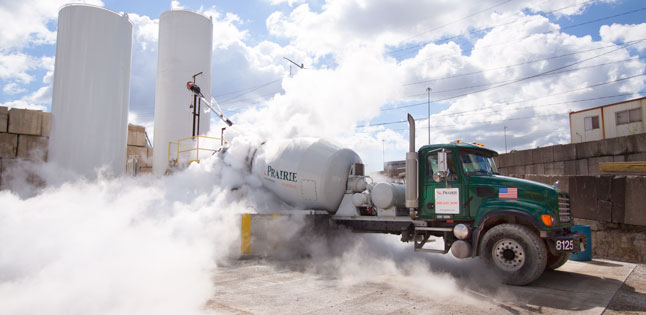
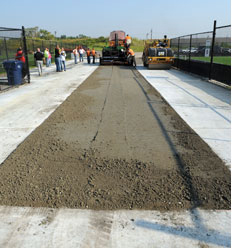
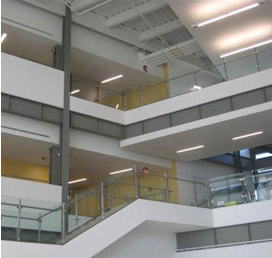


 United Materials
United Materials Superior Materials
Superior Materials Prairie Materials
Prairie Materials Canada Building Materials
Canada Building Materials VC Global
VC Global